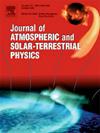Evolution and decay of a stable and a dynamic airglow patch
IF 1.9
4区 地球科学
Q3 GEOCHEMISTRY & GEOPHYSICS
Journal of Atmospheric and Solar-Terrestrial Physics
Pub Date : 2025-07-29
DOI:10.1016/j.jastp.2025.106593
引用次数: 0
Abstract
This study investigates the evolution of two polar cap airglow patches, AGP1 and AGP2, observed over Resolute Bay in northern Canada. AGP1 exhibited stable shape, followed the ExB drift patterns and maintained high electron density as it transited toward the auroral oval, sustaining the maximum F-region density and redline emissions by a downward vertical drift. An initial non-uniform density decay was observed in AGP1’s density profile; the topside shifted downwards, resulting in increased bottomside density. Later, the maximum and bottomside density started to decay. Overall, the downflow contributed to a faster density decay. In contrast, AGP2 displayed dynamic characteristics, halting its motion mid-polar cap, followed by a prolonged decay in both electron density and redline emission. Observations and GEMINI simulations revealed that recombination between atomic ions and neutral molecules was the dominant mechanism for density decay in the optical layer. The decay rate was affected by vertical drift, magnetic field line orientation, and local neutral atmosphere conditions, which may be influenced by prior patch activity. Simulations of AGP1 using GEMINI and GLOW highlight the importance of vertical ExB drift in sustaining electron density maximum and redline emission intensity. By using various free parameters in the model to tune our simulations (e.g. background precipitation) we are able to achieve reasonable agreement with observed patch behavior. Our findings emphasize the interplay between vertical drift, recombination rates, and neutral wind in determining polar cap patch evolution, as well as the complexity of patch dynamics and their dependence on local ionospheric and atmospheric conditions.
稳定气辉斑与动态气辉斑的演化与衰减
本文研究了在加拿大北部Resolute湾观测到的两个极帽气辉斑块AGP1和AGP2的演变。AGP1表现出稳定的形状,遵循ExB漂移模式,并在向极光椭圆过渡时保持较高的电子密度,通过向下的垂直漂移维持最大的f区密度和红线发射。在AGP1的密度分布中观察到初始的非均匀密度衰减;上部向下移动,导致底部密度增加。之后,最大密度和底部密度开始衰减。总的来说,下流有助于更快的密度衰减。相比之下,AGP2表现出动态特性,在极帽中部停止运动,随后电子密度和红线发射都出现了长时间的衰减。观测和GEMINI模拟表明,原子离子和中性分子之间的复合是光学层中密度衰减的主要机制。衰减速率受垂直漂移、磁力线方向和局地中性大气条件的影响,而局地中性大气条件可能受先前斑块活动的影响。利用GEMINI和GLOW对AGP1的模拟表明,垂直ExB漂移在维持电子密度最大值和红线发射强度方面的重要性。通过使用模型中的各种自由参数来调整我们的模拟(例如背景降水),我们能够与观测到的斑块行为达成合理的一致。我们的研究结果强调了垂直漂移、重组率和中性风在决定极地帽斑演变中的相互作用,以及斑块动力学的复杂性及其对当地电离层和大气条件的依赖。
本文章由计算机程序翻译,如有差异,请以英文原文为准。
求助全文
约1分钟内获得全文
求助全文
来源期刊

Journal of Atmospheric and Solar-Terrestrial Physics
地学-地球化学与地球物理
CiteScore
4.10
自引率
5.30%
发文量
95
审稿时长
6 months
期刊介绍:
The Journal of Atmospheric and Solar-Terrestrial Physics (JASTP) is an international journal concerned with the inter-disciplinary science of the Earth''s atmospheric and space environment, especially the highly varied and highly variable physical phenomena that occur in this natural laboratory and the processes that couple them.
The journal covers the physical processes operating in the troposphere, stratosphere, mesosphere, thermosphere, ionosphere, magnetosphere, the Sun, interplanetary medium, and heliosphere. Phenomena occurring in other "spheres", solar influences on climate, and supporting laboratory measurements are also considered. The journal deals especially with the coupling between the different regions.
Solar flares, coronal mass ejections, and other energetic events on the Sun create interesting and important perturbations in the near-Earth space environment. The physics of such "space weather" is central to the Journal of Atmospheric and Solar-Terrestrial Physics and the journal welcomes papers that lead in the direction of a predictive understanding of the coupled system. Regarding the upper atmosphere, the subjects of aeronomy, geomagnetism and geoelectricity, auroral phenomena, radio wave propagation, and plasma instabilities, are examples within the broad field of solar-terrestrial physics which emphasise the energy exchange between the solar wind, the magnetospheric and ionospheric plasmas, and the neutral gas. In the lower atmosphere, topics covered range from mesoscale to global scale dynamics, to atmospheric electricity, lightning and its effects, and to anthropogenic changes.
 求助内容:
求助内容: 应助结果提醒方式:
应助结果提醒方式:


